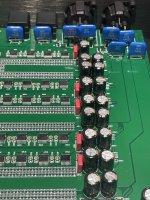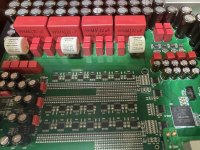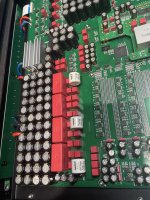Well, in one word, beautiful. I've got to be careful of confirmation bias, but right out of the gate, it's more mellow; hard to describe. Better control, better detail, faster, more - dare I say - romantic sounding. Low frequency extension remains nicely, wonderful detail without any edge - and this is on first power up, 3 sources different tracks to gain a general feel. It's audiophool speak, but it draws you in. I've got to give it more time, but it's to the positive.. Very nice little change.
Attachments
So I can state two weeks later that Mundorf Silver.Gold Oil take a full 2-weeks in an active circuit to burn in. They follow the typical pattern - give a glimpse of what the end result would be, then regress (these did so for 2 weeks), then open up to what the initial experience was. In my DAC application, the caps increased sound stage depth - that is, the distance between the listener and the instruments, but possibly more prominently is the aspect of now being more surrounded by the music. This is the clear difference these fine caps made. Maybe some enhancement in tone, low frequency extension, detail etc, but overwhelmingly the result has been depth and surround. It sounds special, and absolutely no regrets!
Thought I'd share how I finished the job on the Terminator II. Complete re-cap, OS_CON complete on the digital board, Kemet MKT 4.7uF with 100pF MLCC NP0 as bank bypass cap combos. MLCCs used elsewhere - complete removal of all "Elna Silmic II" and "WIMA" MKS. Nichicon RNU on the ladders, Panasonic FM-A on the analogue side bank. Mixed cascaded MKP augmenting the electrolytic bank - of course we still have the Mundorf SGO. I guess I might be one of the few to actually hear a Denafrips Terminator II the right way, it was worth the desoldering marathon and cooking away - a month of burn-in to go...
Completed full-scale replacement of approximately 130 capacitors throughout the T2, addressing every critical subsystem with premium components selected specifically for their application:
The upgrade represents a comprehensive approach targeting every significant weakness in the original design, creating a unit that should exceed the performance of even Denafrips' premium models through both component quality and optimized engineering approaches.






Project Scope:
Completed full-scale replacement of approximately 130 capacitors throughout the T2, addressing every critical subsystem with premium components selected specifically for their application:
Key Technical Findings:
- Original capacitors tested as counterfeit "ELNA" and "WIMA" components
- Measured ESR values of 0.23-0.8Ω on fake film capacitors (vs 0.01-0.03Ω typical for genuine)
- Evidence of deliberate performance limitation through component selection
- PCB silkscreen showed 3.3μF design intent, while installed values were 0.1μF
Component Upgrade Strategy:
Digital Power Section:
- Replaced generic electrolytic bank with Panasonic OS-CON polymer capacitors (16SEPC470M)
- Implemented high-frequency MLCC NP0 bypassing for FPGA power
- Created progressive digital filtering using varied capacitance values
R-2R Ladder Power:
- Implemented Nichicon RNU polymer capacitors (47μF/25V, 24mΩ ESR, 3.6A@100kHz ripple)
- Optimized high-frequency power delivery with KEMET polymer caps
Analog Signal Path:
- Replaced four identical "WIMA" MKS with progressive staggered capacitor array:
- 22μF KEMET MKT (low frequencies)
- 12.5μF KEMET MKP polypropylene (mid-low frequencies)
- 6.8μF Würth MKP polypropylene (mid-high frequencies)
- 1μF Classe MKP (high frequencies)
- Retained three Mundorf Silver/Gold Oil 0.22μF for critical high frequencies
Analog Output Stage:
- Upgraded to Panasonic FM-A series (19-28mΩ ESR, 1.635-2.18A ripple)
- Implemented Nichicon UHV for 270μF requirements
- Added KEMET premium film capacitors for bypass
Technical Design Improvements:
- Eliminated resonance issues through staggered capacitor values
- Created complementary filtering across frequency spectrum
- Optimized ESR characteristics for each application
- Hard-soldered critical clock power connections
- Improved high-frequency noise rejection through strategic bypassing
Current Status:
- Unit is functional with initial break-in underway (~24 hours)
- Bass performance showing first signs of improvement
- Full break-in expected to take 3-4 weeks due to extensive polymer capacitor count
- Expecting progressive improvement in detail retrieval, spatial characteristics and dynamics
The upgrade represents a comprehensive approach targeting every significant weakness in the original design, creating a unit that should exceed the performance of even Denafrips' premium models through both component quality and optimized engineering approaches.
Last edited:
any thoughts on the denafrips board sitting on top of the o core transformers and whether metal shielding on top of transformers is effective in blocking emf/rf noise ?
any thoughts on the denafrips board sitting on top of the o core transformers and whether metal shielding on top of transformers is effective in blocking emf/rf noise ?
Well, I have thoughts, others I'm sure do as well. I think the chassis design and shielding is significantly better than most. While underneath, is it separated by two sheets of the finest in Chinese sheet metal, many units don't come close to it in a one-chassis design. Again, it's not the designs with these things, its the execution in my opinion - parts. I'd be more inclined to replace the wire out of the LPS and address parts within the PSU with as many North American equivalents as I could than worry about the shielding, they did a very good job with that.
Last edited:
one box solutions are always a compromise, I would have the transformers away from the sensitive signal components and in a big box
would expect the effect would be greater detail and airyness as emf tends to affect these qualities
would expect the effect would be greater detail and airyness as emf tends to affect these qualities
Well, I have to say this is really burning in nicely. Rollercoaster of burn-in change, love it. Bass up and down, better 3D, muffled then glare, sounds of vindication.. Much more authoritative..
Last edited:
Have you made a recording of the DAC prior to the parts change and after? The practice can aid in determining the scope of the sonic effects.
I remain uneasy of wound capacitors like these in the vicinity of high-frequency logic circuits, as they are antennas.
I remain uneasy of wound capacitors like these in the vicinity of high-frequency logic circuits, as they are antennas.
I hadn't considered making recordings for comparison - might try that for future mods. Fairly sure what to expect, and it's delivering.
For the capacitor selection, I actually used different types based on their location in the circuit. The digital sections have polymer caps with MLCC bypassing to handle the high-frequency stuff cleanly. The film caps are mostly in the analog sections where they tend to sound best.
One interesting thing I found was that the original WIMAs had much higher ESR than genuine ones should. Based on prior experience with similar upgrades, I'm expecting significant improvements once everything settles. The burn-in is going well so far - bass is already improving, so is the "3D", and I expect more changes as all these polymers settle in over the next few weeks.
For the capacitor selection, I actually used different types based on their location in the circuit. The digital sections have polymer caps with MLCC bypassing to handle the high-frequency stuff cleanly. The film caps are mostly in the analog sections where they tend to sound best.
One interesting thing I found was that the original WIMAs had much higher ESR than genuine ones should. Based on prior experience with similar upgrades, I'm expecting significant improvements once everything settles. The burn-in is going well so far - bass is already improving, so is the "3D", and I expect more changes as all these polymers settle in over the next few weeks.
I have been doing pre-post recording for a long time. Sometimes a modification has a deleterious effect, but is masked by memory and expectation bias. Recording the DUT’s outputs adds the convenience of removing a layer of uncertainty, and diminishes the effects of expectation and memory bias when assessing the final result.
My cautious side suggests the analog end could possibly pick up the digital, even from one side of the case to the other. It might be worth probing with an oscilloscope.
Sometimes, a bit of series resistance in a capacitor can help damp what might otherwise become a resonant circuit. The big thing with wound polypropylene capacitors is the windings can vibrate and they rarely can a metal can to shield them. The Wimas, by comparison, are usually flat stacked and have minimal pickup, particularly in one orientation.
Anyhow, you’ve done a lot of work and I’ll leave you to it.
My cautious side suggests the analog end could possibly pick up the digital, even from one side of the case to the other. It might be worth probing with an oscilloscope.
Sometimes, a bit of series resistance in a capacitor can help damp what might otherwise become a resonant circuit. The big thing with wound polypropylene capacitors is the windings can vibrate and they rarely can a metal can to shield them. The Wimas, by comparison, are usually flat stacked and have minimal pickup, particularly in one orientation.
Anyhow, you’ve done a lot of work and I’ll leave you to it.
I appreciate your interest. While A/B recordings have their place, they wouldn't capture the spatial and detail improvements I'm targeting.
Regarding film capacitors in the analog section - the MKP and Mundorf capacitors I've selected have significantly better performance characteristics than the counterfeit components they replaced. These aren't just random wound caps - they're premium components specifically designed for audio signal paths with proper internal construction.
The Denafrips T2 has proper internal shielding and ground plane design. I've strategically placed different capacitor types where they perform best - polymers in digital power sections and quality film caps in the analog signal path. This isn't theoretical - the ESR measurements of the originals showed 10-20x worse values than genuine components.
Let's be real - replacing counterfeit parts with properly specified components makes an obvious improvement. It already sounds better and will continue improving as burn-in progresses. Cheap Chinese components sound bad, whether they're in the digital or analog sections.
Regarding film capacitors in the analog section - the MKP and Mundorf capacitors I've selected have significantly better performance characteristics than the counterfeit components they replaced. These aren't just random wound caps - they're premium components specifically designed for audio signal paths with proper internal construction.
The Denafrips T2 has proper internal shielding and ground plane design. I've strategically placed different capacitor types where they perform best - polymers in digital power sections and quality film caps in the analog signal path. This isn't theoretical - the ESR measurements of the originals showed 10-20x worse values than genuine components.
Let's be real - replacing counterfeit parts with properly specified components makes an obvious improvement. It already sounds better and will continue improving as burn-in progresses. Cheap Chinese components sound bad, whether they're in the digital or analog sections.
- In a well-engineered device like the Denafrips T2, proper internal shielding, ground planes, and board layout already address potential interference issues
- Digital and analog sections in high-end DACs are deliberately isolated specifically to prevent this type of interference
- Quality film capacitors used in the analog section of audio equipment aren't particularly susceptible to digital noise at the frequencies present in a DAC
- Many of the world's most respected DACs (including tube designs that audiophiles love) deliberately use film capacitors in their analog sections for their superior sonic performance
Last edited:
If that's what you are trying to get to, there are much better ways to do it. Better methods can be much more effective at achieving the desired result than swapping filter caps around without even knowing which particular circuits the caps are being used for....they wouldn't capture the spatial and detail improvements I'm targeting.
If this is true* (that device is not exactly low cost Aliexpress stuff) replacing the fake film caps for original WIMA caps could heave been sufficient. There is really nothing wrong with real WIMA caps not even their MKS2 series. Despite all the flak they get from audiophiles many use these and the Kemet ones to great pleasure. They perform the same.Key Technical Findings:
- Original capacitors tested as counterfeit "ELNA" and "WIMA" components
Also why choose axial 450V caps with way too long lead wires for this low voltage application? You need radial caps and straight to PCB mounting. Maybe the device even measures worse this way.
*Are you sure your measuring equipment is of good quality? It seems Aliexpress stuff, certainly the 29 Euro LCR meter.
OK, I will take this into account next time. Please consider using the cap with its outer foil wire connected to the lowest potential. That way the cap will use its outer foil as shielding.
Tip: measure case temperature of the larger ICs and glue a heatsink on them when they are hot. Lower internal temperature (or better heat transfer to the air) will benefit the electrolytic caps.
Last edited:
First, and most importantly, it's wonderful that you had some fun. I'll call out one potential thing.
Either way, it seems like a ton of fun, and I hope you love it! 🙂
I'll hazard a WAG that with the pulled "fake" parts you used the clip probes and for measuring "real" parts you inserted them directly into the LCR-P1 because you had full leads. You provided photos of the measurements of the "fakes", but you seem to have conveniently left out any evidence of the "control". I could be wrong (and I often am) but an engineer such as yourself would want to be thorough before tossing out serious accusations, wouldn't you? If you did in-fact measure them using an identical process, you'd also want to take into account that the ESR of these capacitors increases over the component's life. How much of a delta did you allow? You did not state the number of hours on the unit. Your findings / readings may be correct, but the explanation for how you came to such a bold conclusion and the methodology for determination is lacking.
- Original capacitors tested as counterfeit "ELNA" and "WIMA" components
- Measured ESR values of 0.23-0.8Ω on fake film capacitors (vs 0.01-0.03Ω typical for genuine)
And that is why you'll likely hear those improvements.
- Expecting progressive improvement in detail retrieval, spatial characteristics and dynamics
Either way, it seems like a ton of fun, and I hope you love it! 🙂
(that device is not exactly low cost Aliexpress stuff)
Hey Jean-Paul, ah, but unfortunately it is... When we get down to the parts level.. On the real WIMA to Kemet, you're probably right, preference in my case, that's all, main thing was getting rid of the cheap films.
Also why choose axial 450V caps with way too long lead wires for this low voltage application?
Because they say Mundorf on them. 🙂 of course.
swapping filter caps around without even knowing which particular circuits the caps are being used for.
That's a bit of an assumption there.
Look gents, classic case of a Chinese design of decent smarts with flawed execution from parts. It's a movie we see over and over. By the questioning, I'm flattered by the attention, but what are we suggesting - Denafrips got it totally right with all genuine parts and I went about this like some kind of ignoramus replacing their premium stuff in search of subjective improvements without any regard to all of the stock quality which the T2 from China exudes? No..
We have a scenario where 48hr after it's already outperforming how it was by a nice margin and not through settling in period. This I know since all I do is sit and listen to the same streams. No regrets from me.
Last edited:
- Home
- Source & Line
- Digital Line Level
- Denafrips Terminator II WIMA Caps




